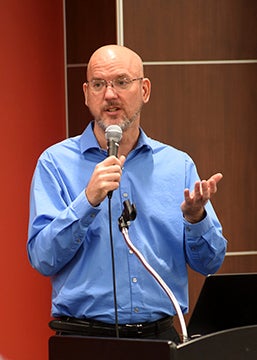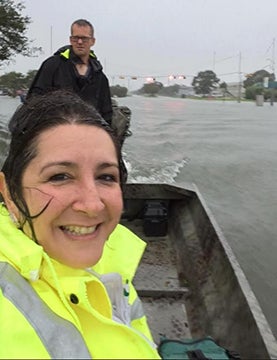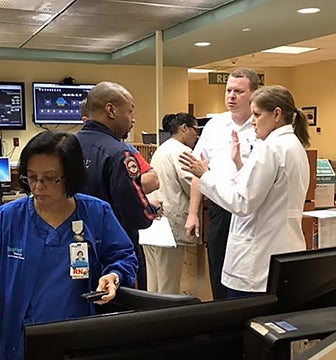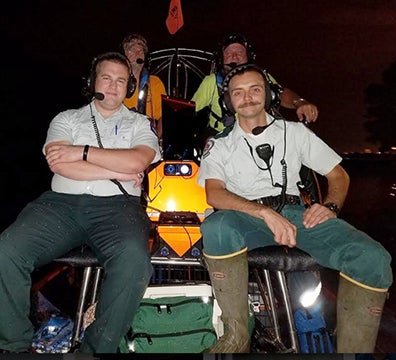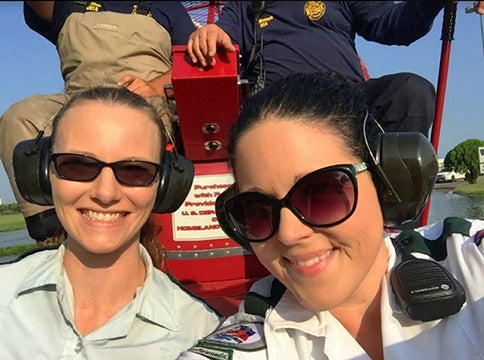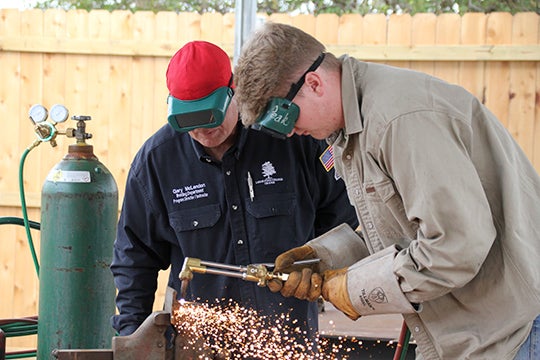BEYOND THE STORM — Through the eyes of the rescuers: Acadian Ambulance used what they had to make it through the storm
Published 4:58 pm Tuesday, May 1, 2018
The staff at Acadian Ambulance knew a hurricane could come at any point. It was just a matter of when.
“We had been having meetings for weeks,” said Frances Garza, a Port Arthur operations supervisor for Acadian. “Jon had been keeping us up to date with the news reports on the weather and what to expect and everything. It’s not our first hurricane to work, so we knew to prepare our people.”
Jon Clingaman, the operations manager for Acadian Southeast Texas (covering Jasper, Tyler, Hardin, Jefferson and Orange counties), relies on forecasts from the National Weather Service office in Lake Charles in addition to working with the Texas Department of Public Safety and Texas Department of Emergency Management in preparing for disasters such as hurricanes.
“It’s more centralized and we’re able to synergize all the more information when we deal with the National Weather Service,” Clingaman said.
Hurricane Harvey initially touched down on the Texas Coast on Aug. 26 near Rockport, and it was only a matter of knowing when the weather system would affect Jefferson County, if at all.
“So, we started weeks prior preparing,” Garza said. “We had our staff make plans to keep their family safe and to make preparations to be here for the duration. Once you’re here, you’re stuck here, and there are jobs to be done.”
Acadian’s offices in Beaumont were turned into temporary living quarters with cots, beds, canned foods, toiletries and mobile shower stations. Garza was on duty Aug. 29, the day Harvey returned to the coast through Jefferson County as a tropical storm, and went to the Acadian quarters in Mid- and South County to make sure all workers were taken care of.
“We started calling in some of our people who were scheduled the next day,” she said. “We had a contingency plan. We were just trying to get our people in and make sure we had coverage.”
Yet, nothing could prepare Acadian’s men and women for what was to come.
Aug. 29
Jefferson County had already been deluged with inches of rain from Harvey over the weekend, but the worst was yet to come.
“I spent the latter part of my day going around and getting employees, when the water started rising, from their high point where they could leave their vehicle, and I’d take them on in to their unit they were assigned to,” Garza said. “Calls started coming in, people got excited and nervous about their houses flooding or the city flooding.
“We didn’t really have a place to pick someone up and take them to a shelter, so we had a lot of bed-bound patients calling. I don’t think it was a mandatory evacuation at that point, so we didn’t have a shelter. So, we could go check on people and make sure we had everything they needed. We spent the rest of the first day of the rainfalls doing that kind of stuff.”
One of the emergency shelters, the Bob Bowers Civic Center in Port Arthur, flooded overnight, so evacuees were sent to the Carl Parker Center at Lamar State College Port Arthur.
Between 5 p.m. and midnight, Garza estimated hundreds of calls were made to Acadian. So, the service had to triage each call, or determine a response to each call based on the severity of the medical situation.
“We had to go through those calls and determine if they were A) something that was life threatening B) had a lower priority or C) ‘I’m scared and I don’t know what else to do,’” Clingaman said. “What we had to do was figure out if we needed to find a way to get there, because you know the flooding is what hampered a lot of the situations we dealt with. And it was truly a flash flood where the weather just kept coming up, coming up and coming up, so we had to work closely with the fire department in Port Arthur, the sheriff’s department and the game wardens in Florida. There were some game wardens that showed up from Florida. We had to get on those boats and determine a way to check on them and see if they had a medical emergency or if it was a welfare check.”
Garza worked the area around Ninth Avenue, while water was rising, with volunteers boating to help those in need. Meanwhile, a school in West Port Arthur, she recalled, had an Acadian crew the Port Arthur Fire Department commandeered to assist evacuees.
Garza got into a boat with one of the PA police officers and followed a PAFD unit around in her part of town.
“We had some medical emergencies,” she said. “We had a lot of chest pain calls, a lot of anxiety calls and seizure activity. People are starting to get scared, and the emergencies are starting to pick up. So, we go in the boats and we get the patients in the boats and whoever else is in the household, we go ahead and bring them in the boats because we were going to have to evacuate them all.”
Turns out, a mandatory evacuation was never ordered.
Aug. 30
“The morning after that initial landfall, there were several calls in our cube, close to 100,” Clingaman said. “The phones continued to ring, and with the redundancy of our disaster plan, our dispatchers and call-takers were inundated here, so we were able to bring in additional staff in Austin and have our phones answered in our Austin call center.
“… That made a big difference because what that would then allow is our dispatchers and call-takers here to work together to triage the calls and get the people and resources to those locally that were needed.”
An Acadian call center in Lafayette, Louisiana, also serves as a backup to the Beaumont personnel.
All hands on deck, 230 people in the Beaumont unit covered a number of Southeast Texas communities, and Clingaman’s group would need extra help.
“We sent a strike team of ambulances from Louisiana, which is five ambulances, and there were also eight additional ambulances from Austin and Dallas, so an additional 13 ambulances alone, and we put up an additional 30 ambulances here,” he said, adding 50 to 75 people came from the three assisting Acadian centers.
The dilemma now was how to service each community in distress. The rising flood, which crested on this day, forced Acadian to divide its leadership into a supervisor each in Port Arthur, Orange County and three locations in Hardin County (Lumberton, Kountze and Silsbee) as well as sending team members to Baptist Hospital in Beaumont to help with evacuations, Clingaman said.
“Although we utilized all of our local resources, we were able to backfill those positions and not see a level of change in our service,” Clingaman said.
Meanwhile, Garza was still on Ninth Avenue in Port Arthur, navigating the neighborhood by boat.
“We got people out of their homes if they chose to go … we were bringing them to a high point that was Max Bowl on Ninth Avenue,” she said. “It was the largest facility around, and the fire department chose to go ahead and we commandeered that building. …
“We used what we had to make it through the night.”
Boat rescues stopped after dark, Garza said, because of severe lightning. She and her crew got a head count of those rescued at Max Bowl and triaged everyone’s medical situation.
She “hiked out” those who were ill and arranged ambulances to meet them at Fresenius Medical Care in Port Arthur on the next block north.
“We would hike them through the water, and we would get on the other side and put them in an ambulance and they could take them to the emergency room that was next door or wherever they were able to get them,” Garza said.
Aug. 31
The sun might have peaked, but the aftermath of Harvey’s impact was just beginning.
“Once the rain finally stopped, the water didn’t stop rising,” Clingaman said. “People started realizing, ‘I need to get out of my home,’ or ‘I can’t get to my home.’ In our training and meeting we have, there are two storms we look at, and that is either a windstorm, as a hurricane, or a tropical storm, as Harvey made landfall as.
“It impacted us in a way that — not that we weren’t familiar with — but we weren’t prepared for. We were prepared for 15 to 18 inches, and it turned out to be over 50. Our preparation led us to things that we have not ever seen in any of our lifetimes.”
The phones continued to ring for about five days, Clingaman estimated, all hands still on deck and backup in place. Garza saw how many of her crew members worked themselves to injury and exhaustion, needing wound care and other treatment.
“Working in the water nonstop for as long as they could do, I guess the hardest thing for me was to motivate my people and myself to keep going … because I know my people were tired and just wanted to go home and check on their own families. You just keep going. That’s what you’re called to do,” Garza said.
By this time, Clingaman worked with National Guard and local responders to get nursing home patients to a safe location in Conroe through air evacuations.
“We came, we saw and we left,” he said. “We got those patients out, we got them to where they belonged, and we moved on to the next assignment. The next assignment was to be with Baptist Hospital in Beaumont for two days with no sleep, around-the-clock evacuating 200 patients, and overseeing that evacuation working with our state partners to get the resources we need.”
Air evacuation was one way Acadian solved the problem of transporting patients safely as water continued to divide Southeast Texas.
“I think what we learned is that we’re able to work with agencies and we are able to adapt and overcome,” Clingaman said. “There were so many different variables — acute-care facilities, nursing-care facilities, assisted-living facilities that have plans in place to be prepared for this, yet in the middle of the night when the deluge of rain continued and impacted those facilities, it was basically a hurdle and too late for us to respond because it began to segment our area into different pieces. You couldn’t get over the state line. You couldn’t get from Houston. Southeast Texas became an island with islands among us, and it was something that continued for 48-72 hours to where we’re doing rescues before we get in recovery mode.”
The aftermath
The death toll from Hurricane and Tropical Storm Harvey reached 93 on Oct. 16, according to the Texas Medical Association, citing Texas Department of State Health Services.
Hundreds of thousands in Coastal Texas were left to cope with the effects and dangers Harvey onset, and emergency medical technicians and paramedics alike were not immune to physical or mental health effects of what’s been nicknamed the “1,000-year flood.”
“Everybody has a different coping mechanism,” Clingaman said. “Some folks wanted to be at home and check on their home and their loved one and make sure everything was going to be OK and then go back to work, or go find the damage and say, ‘I’ve got to go help others.’ Every one of our employees, they gave of themselves selflessly, for certain.”
Motivating employees to keep going, however, was simple, he added, because of the sense of responsibility they feel in their profession.
“They give of themselves even in an everyday situation, whether we’re dealing with a 2-year-old hit by a car or a 90-year-old person who dies of natural causes,” Clingaman said. “Our employees are empathetic, and many of them sympathetic to these situations, and they either hold a hand, say a prayer, they have a way of reaching out to these people. Our team members, they pull together. They support each other.”
This story appeared in Volume 2 of The Port Arthur News Profile, April 15, 2018
More Profile
